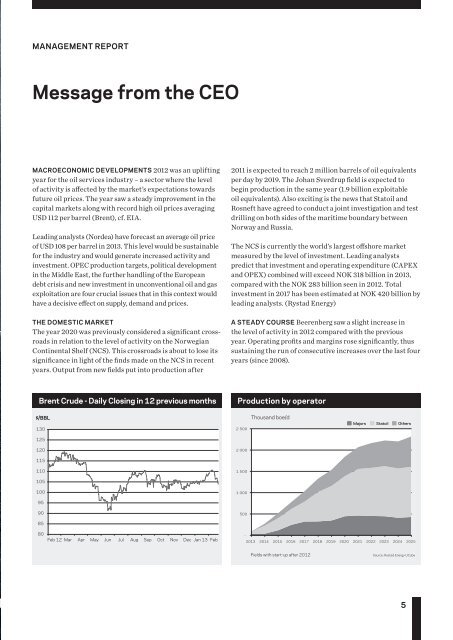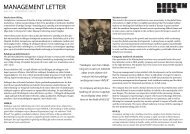Note 1 - Beerenberg
Note 1 - Beerenberg
Note 1 - Beerenberg
You also want an ePaper? Increase the reach of your titles
YUMPU automatically turns print PDFs into web optimized ePapers that Google loves.
Management report<br />
Message from the CEO<br />
Macroeconomic developments 2012 was an uplifting<br />
year for the oil services industry – a sector where the level<br />
of activity is affected by the market’s expectations towards<br />
future oil prices. The year saw a steady improvement in the<br />
capital markets along with record high oil prices averaging<br />
USD 112 per barrel (Brent), cf. EIA.<br />
Leading analysts (Nordea) have forecast an average oil price<br />
of USD 108 per barrel in 2013. This level would be sustainable<br />
for the industry and would generate increased activity and<br />
investment. OPEC production targets, political development<br />
in the Middle East, the further handling of the European<br />
debt crisis and new investment in unconventional oil and gas<br />
exploitation are four crucial issues that in this context would<br />
have a decisive effect on supply, demand and prices.<br />
The domestic market<br />
The year 2020 was previously considered a significant crossroads<br />
in relation to the level of activity on the Norwegian<br />
Continental Shelf (NCS). This crossroads is about to lose its<br />
significance in light of the finds made on the NCS in recent<br />
years. Output from new fields put into production after<br />
2011 is expected to reach 2 million barrels of oil equivalents<br />
per day by 2019. The Johan Sverdrup field is expected to<br />
begin production in the same year (1.9 billion exploitable<br />
oil equivalents). Also exciting is the news that Statoil and<br />
Rosneft have agreed to conduct a joint investigation and test<br />
drilling on both sides of the maritime boundary between<br />
Norway and Russia.<br />
The NCS is currently the world’s largest offshore market<br />
measured by the level of investment. Leading analysts<br />
predict that investment and operating expenditure (CAPEX<br />
and OPEX) combined will exceed NOK 318 billion in 2013,<br />
compared with the NOK 283 billion seen in 2012. Total<br />
investment in 2017 has been estimated at NOK 420 billion by<br />
leading analysts. (Rystad Energy)<br />
A steady course <strong>Beerenberg</strong> saw a slight increase in<br />
the level of activity in 2012 compared with the previous<br />
year. Operating profits and margins rose significantly, thus<br />
sustaining the run of consecutive increases over the last four<br />
years (since 2008).<br />
Brent Crude - Daily Closing in 12 previous months<br />
Production by by operator<br />
$/BBL<br />
130<br />
2 500<br />
Thousand boe/d<br />
Majors Statoil Others<br />
125<br />
120<br />
2 000<br />
115<br />
110<br />
1 500<br />
105<br />
100<br />
1 000<br />
95<br />
90<br />
500<br />
85<br />
80<br />
Feb 12 Mar Apr May Jun Jul Aug Sep Oct Nov Dec Jan 13 Feb<br />
-<br />
2013 2014 2015 2016 2017 2018 2019 2020 2021 2022 2023 2024 2025<br />
Fields with start-up after 2012<br />
Source: Rystad Energy UCube<br />
5












